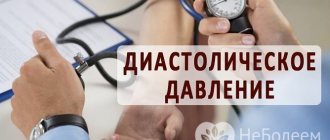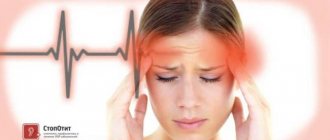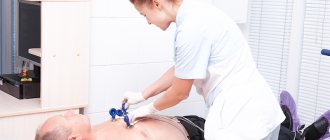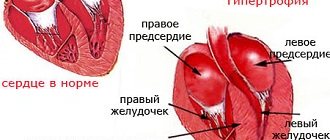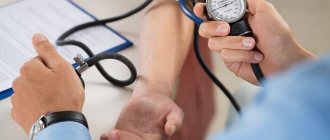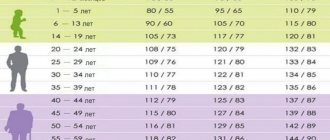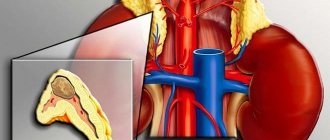High blood pressure or arterial hypertension is considered the most common reason for visiting a cardiologist. According to WHO, it affects 20 to 30% of the world's adult population. With age, the situation only gets worse - more than half of older people over 65 years of age have this disease, and its hemorrhagic complications (stroke, heart attack) often become fatal for a person.
Let's consider the norm and pathological changes, including those that threaten the transition to a hypertensive crisis. Let's touch on the causes, signs and methods of correcting high blood pressure?
What is high blood pressure?
High blood pressure (BP) is said to occur when its systolic and diastolic components rise above the physiological threshold.
Normal blood pressure according to WHO:
- systolic (upper) – 120-129 mm Hg. st;
- diastolic (lower) – 80-84 mm Hg. Art.
If, when measuring blood pressure, the upper number is 140 or higher, and the lower number is 90 or higher, then this pressure is considered elevated. It should be understood that systematically recorded high blood pressure is considered a pathology. Episodes of its increase in the morning, during intense physical activity, fear, and stress are natural for the body.
According to medical observations, the following blood pressure levels are considered very dangerous - for the upper 180, for the lower 120. In this case, there is a high probability of developing a hypertensive crisis.
Causes of high blood pressure
Doctors most often record an increase in blood pressure in people with a hereditary predisposition and/or diseases of other organs and systems (pheochromocytoma, hyperthyroidism, atherosclerosis, diabetes, etc.), leading to the development of hypertension as a symptom.
The mechanism of blood pressure increase is realized in two ways:
- neurogenic – vasoconstriction through the response of the sympathetic nervous system;
- humoral – release of vasopressors (catecholamines, renin-angiotensin, etc.) into the blood.
Also important is the disruption of the depressor system, which is responsible for vasodilation.
At the same time, a number of factors that trigger the process of hemodynamic disturbances have long been identified:
- excess weight;
- little daily activity;
- poor nutrition, including preference for fast food, snacking on carbohydrate foods;
- chronic intoxication caused by smoking, alcohol abuse, drug addiction;
- mental and physical stress;
- lack of sleep;
- hormonal changes during puberty, pregnancy, menopause;
- abuse of salt in the diet;
- elderly age;
- harmful working conditions;
- taking medications that can indirectly affect blood pressure (for example, hormonal contraceptives , appetite suppressants, etc.)
With high blood pressure, it is important to monitor the reduction of the influence of these factors in everyday life, which will help reduce the risk of developing the most threatening complications - stroke and heart attack.
On a note:
- Hypertension is a multifactorial disease that manifests itself as a persistent increase in blood pressure and depends on genetic predisposition and lifestyle.
- Men over 55 years of age and women over 65 years of age are at risk for the disease. However, the disease is also common among young people and children.
- Hypertension is a “silent killer” because it is often asymptomatic. To find out the presence of the disease, you need to regularly monitor your blood pressure levels and consult a specialist. Genetic testing will help determine predisposition and prevent the development of the disease.
- If your blood pressure suddenly increases, it is important to call a doctor or take medications recommended by a specialist. Self-medication with folk remedies for this condition is ineffective and even dangerous.
- Risk factors for high blood pressure: age, heredity, lack of physical activity, excess weight, smoking, alcohol, excess salt and lack of potassium, stress and chronic diseases.
- Hypertension negatively affects all areas of a person’s life. A hypotensive person must take medications regularly, limit diet and exercise. Headaches, cerebrovascular accidents, edema, increased risk of developing atherosclerosis, heart and kidney diseases are companions of arterial hypertension.
- Hypertension cannot be cured, but symptoms can be controlled with medications and its progression can be prevented with a balanced diet, regular exercise and stress reduction.
Sources:
- Oparil S. et al., Hypertension Review
- Williams B. et al.,2018 ESC/ESH Guidelines for the management of arterial hypertension: The Task Force for the management of arterial hypertension of the European Society of Cardiology (ESC) and the European Society of Hypertension (ESH)
- Umemura S. et al.,The Japanese Society of Hypertension Guidelines for the Management of Hypertension
- Curfman G. et al., Treatment and Control of Hypertension in 2020: The Need for Substantial Improvement
- High blood pressure (hypertension)
- High blood pressure//Prevention//Causes//Diagnosis//Treatment
Symptoms and signs of high blood pressure
Many people know that hypertension is often asymptomatic, but this is noted only at the beginning. Constantly high blood pressure over time results in a number of clinical symptoms:
- The first signs: rare headaches, dizziness, fatigue, weakness, nervousness, sleep disturbance;
- As it progresses: headaches in the occipital region, “tingling” in the heart area, the appearance of shortness of breath during light physical activity (walking, for example), a feeling of heartbeat, “spots” before the eyes, visual impairment.
External signs of hypertension in men and women are no different. The difference in symptoms mainly depends on the level of pressure and the rate of its increase. Often a sharp increase in blood pressure threatens the development of a hypertensive crisis and rupture of the vessel wall.
Atypical manifestations
Sometimes hypertension manifests itself atypically; it can be difficult to suspect it in the presence of such uncharacteristic symptoms, especially for an ordinary person who does not have a medical education. Symptoms that are not typical for high blood pressure:
- visual acuity is impaired;
- kidney problems (frequent urination at night, urine analysis reveals protein, red blood cells, white blood cells);
- erectile dysfunction in men;
- menstrual irregularities in women.
High lower pressure: causes, symptoms
By lower or diastolic pressure we mean the force with which the blood flow acts on the vessels during the diastole (relaxation) phase of the heart. Its value depends on the degree of vascular resistance, an increase in which is observed in the following pathological conditions:
- atherosclerosis - the elasticity of the walls of blood vessels decreases, their lumen decreases, which increases tone and resistance to blood flow;
- kidney pathology leads to vasoconstriction due to the implementation of the renin-angiotensin-aldosterone reaction;
- anatomical and functional changes in the myocardium (dilation of the heart chambers, arrhythmia);
- thyrotoxicosis – a high concentration of thyroid hormones in the blood causes vasospasm;
- diabetes mellitus – vascular patency is impaired;
- tumor of the pituitary gland and adrenal glands - the release of catecholamines into the blood, which constrict blood vessels;
According to statistics, the elderly population and men of any age often suffer from high blood pressure. Signs of its increase are sharp pain in the head, dizziness, tinnitus, and attacks of shortness of breath. Painful discomfort in the cardiac region is possible. Long-term high diastolic pressure threatens the development of a heart attack or stroke.
Consequences of hypertension
The higher your blood pressure, the harder the work your heart has to do to maintain normal blood circulation. Therefore, if hypertension is not treated, the walls of the heart first thicken or hypertrophy, which increases the risk of the heart working intermittently, and later the walls of the heart become thinner, which leads to disruption of the blood supply to the tissues and the heart itself and is accompanied by the appearance of shortness of breath, fatigue, and swelling in the legs. These signs often indicate the development of heart failure, which is the inability of the heart muscle to perform its normal pumping function.
High blood pressure accelerates a process known as atherosclerosis, which is the formation of fatty deposits on the walls of the arteries, causing them to harden, thicken, and reduce the lumen of the vessels. If the coronary arteries that supply blood to the heart are affected, angina pectoris or angina pectoris develops. As the process progresses, one of the arteries may become completely blocked, then part of the heart muscle stops receiving blood, and myocardial infarction develops. Atherosclerosis can affect any part of the arterial bed. If cerebral vessels are damaged, a patient with hypertension is highly likely to develop a cerebral stroke, which impairs motor abilities, speech and memory. When the blood vessels of the eyes, kidneys and lower extremities are affected, there is a high risk of developing blindness, renal failure and “intermittent claudication”.
Increased upper pressure: causes, symptoms
Upper (systolic) pressure reflects the contractile activity of the myocardium during systole. Its increase may be due to various reasons:
- congenital defects and acquired cardiac pathology - coarctation of the aorta, PDA, blockade of the atrioventricular node, insufficiency of the valves at the entrance to the aorta;
- ion deviations - accumulation of sodium and calcium in the blood;
- atherosclerosis of large and small vessels;
- renal pathologies of an inflammatory, autoimmune nature;
- diabetes;
- dehydration of the body.
Over time, increased upper pressure first leads to hypertrophy, and then to wear and tear of the myocardium and the formation of heart failure. The aortic wall becomes rigid due to constant trauma by increasing blood pressure. Hemodynamic disturbances of internal organs are also noted due to inadequate distribution of blood through the vessels.
This type of hypertension is more often recorded in women. It manifests itself as regular headaches, discomfort in the heart, fatigue, memory impairment, tinnitus, and decreased vision.
Treatment of high blood pressure
The main goal of therapy for high blood pressure is to reduce its levels to normal and the maximum possible correction of risk factors (fighting smoking, alcoholism, losing excess weight, doing morning exercises), as well as slowing down the damage to other organs.
Taking into account anamnestic and objective data, various medications are prescribed for hypertension; their main groups are presented below:
- antihypertensive medications to lower blood pressure;
- disaggregants that reduce the risk of hemorrhagic complications;
- statins for correction of lipid metabolism;
- diuretics that indirectly reduce blood pressure;
- according to strict indications, a and/or β-blockers to correct myocardial contractility.
If high blood pressure is a sign of pathology in another organ, then treatment of the underlying disease will be key.
An important aspect in the treatment of high blood pressure is a balanced diet, in which you need to limit salt intake, eat more vegetables, nuts, fruits, healthy vegetable oils (olive, pumpkin). If possible, replace red meat with fish. Reduce the amount of calcium-rich dairy products in your diet.
Prevention
The coherence of the heart and blood vessels is a key link in the health of the whole organism. Thanks to preventive measures, it is possible to maintain their harmony, thereby preventing the development of hypertension. These include:
- a measured lifestyle with adequate physical activity;
- weight loss to normal levels;
- balanced diet;
- quitting smoking, alcohol, drugs.
If the symptoms described above appear, you should begin to systematically measure blood pressure using a tonometer. Regardless of the reasons for high blood pressure, its long-term retention at high levels is a reason to contact a therapist or cardiologist.
Specifics of symptoms in men
Men are less susceptible to nervous conditions and hormonal surges than women. Symptoms of high blood pressure in men depend on the amount by which blood pressure increases compared to normal. If the indicators increase by less than 20 units, the following are observed:
- hyperemia;
- headaches in the temporal part;
- increased irritability;
- the sound of blood pulsating in the ears.
When blood pressure increases by more than 20 units, the following may appear:
- anxiety;
- chest pain;
- increased sweating;
- difficulty breathing;
- increased heart rate;
- coldness in the extremities;
- pain in the temples;
- heat;
- visual impairment;
- facial redness.
If blood pressure increases sharply, then signs of high blood pressure in men are complemented by dizziness and vomiting. A hypertensive crisis may be accompanied by fainting.
When high blood pressure is detected in an adult and symptoms are present, it is necessary to pay attention to the reasons leading to this condition, as well as receive the necessary treatment. It is also important to know how to provide assistance to the patient before the doctor arrives.
The cause is most often a stressful situation and hereditary predisposition. In addition, blood pressure increases due to:
- Abuse of salty foods, since salt retains fluid in the body. Excess fat in the diet also plays a bad role.
- Excess body weight. Overweight people need more blood to supply tissues and organs, and the vessels for pumping it remain the same as before gaining weight. They are under excessive pressure.
- Insufficient supply of potassium and magnesium to the body. Potassium ensures the removal of excess salts. Magnesium deficiency leads to heart muscle weakness and thrombosis.
- Physical inactivity. It leads to the vessels losing their elasticity and ability to stretch when moving large blood flows.
- Smoking and drinking alcohol. Smoking promotes thrombosis. The blood vessels of a smoker narrow when blood enters them.
- Hormonal diseases of internal organs.
- Physiological characteristics of the patient.
- Age-related diseases of the cardiovascular system.
Caffeine intake leads to a one-time slight increase in blood pressure. Blood pressure also increases with physical exertion and fatigue.
If the patient has high blood pressure, the symptoms and treatment are determined by the therapist. Also, this pathology is specialized for a cardiologist and endocrinologist. Drug treatment involves taking:
- Diuretics. They remove excess fluid from the body. When prescribing them, the doctor takes into account contraindications, which are diabetes or gout.
- Alpha blockers, which reduce blood pressure without significantly affecting heart rate. They contribute to the normalization of blood lipid status and do not affect blood glucose levels. The disadvantage of their effect is that upon first use the patient may feel dizzy. Therefore, it is worth taking the drug at night.
- Beta blockers are very effective in lowering blood pressure. They act on the rate of contraction of the heart muscle, reducing it. Due to this, blood pressure drops. Medicines in this class reduce the influence of the nervous system on the functioning of the heart.
- ACE inhibitors. These medications prevent the production of angiotensin II, a hormone that causes blood vessels to constrict. Peripheral vessels dilate and blood pressure drops.
- Calcium antagonists that dilate blood vessels.
- Angiotensin II antagonists.
With high blood pressure, symptoms and treatment are related. The doctor can prescribe specific medications based on the tonometer readings and the symptoms of hypertension.
Mechanical tonometer for measuring blood pressure
An experienced hypertensive patient knows how to lower blood levels. He increases the dose of his regularly taken medications and takes a drug recommended by his doctor for a sudden increase in blood pressure. If your blood pressure has increased for the first time, you should:
- seat the patient on the sofa, placing pillows on his back;
- give him a hot water foot bath (there are contraindications to this method!);
- put mustard plasters on your calves and shoulders;
- if you complain of chest pain, give the patient a nitroglycerin tablet or an aqueous solution of Valocordin in the recommended dose;
- to reduce blood pressure, the patient can take Corinfar in the smallest dose, placing the tablet under the tongue (it is not given to pregnant and lactating women or patients with heart failure);
- ventilate the room, dim the lights, avoid unnecessary noise.
Emergency medical assistance should then be called.
With high blood pressure with severe symptoms, it is necessary to understand the causes and know the principles of treatment, including developing the right lifestyle and taking preventive measures. You should:
- give up bad habits - drinking alcohol and smoking;
- minimize the consumption of salt and fatty foods;
- devote time to simple physical exercises;
- walk more;
- sleep at least 8 hours at night;
- do not sit for hours at a TV or computer;
- try to lose body weight;
- protect yourself from stress;
- conduct courses of massage of the head and collar area.
To normalize blood pressure, it is useful to do breathing exercises. Special herbal infusions that can be bought at a pharmacy and prepared at home can help lower the levels. No-spa will help with headaches. Tablets or infusion of valerian and motherwort help stabilize blood pressure.
In some cases, signs of high blood pressure and symptoms do not make it possible to clearly diagnose hypertension. To determine specific indicators, it is necessary to measure blood pressure using a tonometer according to the following rules:
- 30 minutes before measurement, stop physical work;
- During the same period of time, you should not smoke, drink alcoholic or tonic drinks;
- carry out the procedure in a room at average air temperature;
- sit on a chair near the table, put your hands on the table, put your feet on the floor;
- carry out measurements on both hands 2 – 3 times;
- take measurements at different times of the day.
The cuff is placed on the shoulder part of the arm. The phonendoscope is inserted under the cuff from below, on the elbow. First, the pressure is injected with the device, then it is gradually reduced. At the same time, a phonendoscope is used to determine the number at which the pulse begins to beat, and the number at which it disappears. These two indicators make up the blood pressure values.
